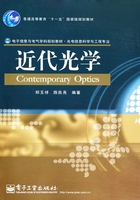
4.1 各向异性介质中的电磁场方程[2],[14],[21],[45]
在空间无自由电荷和传导电流情况下,麦克斯韦方程组为




对于光在各向异性介质传播的情况,上面四个方程与各向同性介质中的方程一样,不同的是相应的本构关系不同。在各向同性介质中,本构关系为


其中,εr为标量,μr≈1。在各向异性介质中,一般仍然有μr≈1,而εr变为张量。
4.1.1 各向异性介质的介电张量
在各向异性介质中,D与E之间满足

式中,ε和εr分别为介电张量和相对介电张量,表示为


ε和εr满足

介电张量是二阶张量,共有九个分量。可以证明,介电张量是二阶对称张量,因此只有六个独立分量。若选择适当的坐标系,可以将对称张量化为对角形式,即

其中,εx、εy、εz称为介质的主介电常数。当介质具有一定的对称性时,介电张量的独立分量数目还要减少。各向异性材料主要是晶体材料,根据晶体的对称性可将晶体分为七大晶系,分别是三斜晶系、单斜晶系、正交晶系、三角晶系、四方晶系、六角晶系和立方晶系。经对角化后,具有不同对称性晶体的介电张量矩阵如表4.1-1所示。
表4.1-1 具有不同对称性晶体的介电张量矩阵

下面讨论介电张量的对称性。由麦克斯韦方程组前两式


将E点乘式(4.1-8b),减去H点乘式(4.1-8a)得

用坡印廷矢量S将上式改写为

根据能量守恒定律,能流密度散度的负值等于单位时间内能量密度W的增量,即

因此

或

根据张量的求和规则,上式右侧第一项指标i、j互换,等式仍然成立,于是有

上式对每个场分量均成立,因此有

4.1.2 晶体的主折射率
对于各向同性介质,其折射率n与介电常数εr的关系为
n= 
对于各向异性介质,其折射率也具有各向异性,相应于前面提及的主介电常数,引入主折射率的概念,即令
ni=  (i=x,y,z)
(i=x,y,z)
在主轴坐标系中,有
Di=ε0εriEi(i=x,y,z)
由此可见,在主轴方向上,D与E平行。
4.1.3 光波在晶体中的能量传播
设在晶体中传播的单色平面光波的各场矢量为

将上式各场量代入麦克斯韦方程组第一式(4.1-1a),得

式中,x0、y0、z0分别为x、y、z轴的单位矢量。由式(4.1-17)可得

此式说明,磁场强度矢量H与电场强度矢量E、波矢k正交。同理得

即

此式说明,电位移矢量D与磁场强度矢量H、波矢k正交。而坡印廷矢量为

S与E、H垂直。于是可知各矢量之间的几何关系,如图4.1-1所示。

图4.1-1 晶体中平面光波各矢量之间的关系
从图4.1-1中可以看出,E、D、k、S均在与H垂直的平面P1内。E与D之间的夹角为α,k与S之间的夹角也为α。S代表光波能量的传播方向,即光线方向,而波矢k的方向即波阵面的法线方向,也就是等相面前进的方向。一般来说,当光波在各向异性介质中传播时,光波能量的传播方向与波阵面的传播方向并不一致,相应的速度即光波能量的传播速度和相速也不同。
由电磁场的知识可知,电磁波的总能量密度是其电能密度与磁能密度之和,即

将式(4.1-18)及式(4.1-20)代入式(4.1-22)可得

式中,k0、s0分别为k与S的单位矢量。进一步将式(4.1-23)写成

而光波传播的相速为

光波能量传播速度即光线速度为

引入光线折射率nr,令nr=c/vr,由式(4.1-24)得

相速与光线速度之间的关系为

可见,相速是光线速度在波法线方向上的投影,并且等相面的传播速度不会超过能量的传播速度。
4.1.4 菲涅耳法线方程
由式(4.1-18)及式(4.1-20)可得

式中,k=kk0= (ωn /c)k0。根据矢量运算公式A×(B×C)=B(A·C)-C(A·B),得

或

写成分量形式得

或

因为电位移矢量D与波矢k正交,即D·k=0,于是有

上式为菲涅耳法线方程。注意到

由菲涅耳法线方程可得

若将

展开,可得



这是一组关于Ei(i=x,y,z)的齐次线性方程组,该方程组具有非零解的条件是系数行列式为零,因此得到

上式称为久期方程,是一个关于n2的二次方程。当光线方向一定时,解方程得n2 的两个本征值
n'2、n″2,代入方程组得本征矢E'与E″分别为

对应的D'与D″为

可以证明,D'与D″正交,即D'·D″=0。证明过程如下:

事实上,n'与n″分别满足公式(4.1-34),显然有

根据以上讨论可以得出下面几点结论。
(1)在一般情况下,对应于晶体中每一个特定的波法线方向k,存在两个本征传播模,每一个传播模是一束单色线偏振光。
(2)这两束线偏振光的电位移矢量相互垂直,即D'⊥D″,并且两者都垂直于k,即D'⊥k,D″⊥k。
(3)这两束线偏振光在晶体中具有不同的传播速度,即相应的折射率n'与n″不同。
(4)对应于同一个波矢k,与D'、D″相应的电场矢量分别为E'、E″。E'与E″一般不一定正交,S'、S″方向也不一样,于是出现双折射现象。
4.1.5 菲涅耳光线方程
由矢量E和D之间的关系

用D点乘上式得

即

或者

α为E与D之间的夹角,也为k与S之间的夹角,或者光线速度vr和法线速度(相速)vp之间的夹角,且有

根据光线折射率定义

将式(4.1-47)写为

根据矢量E和D之间的几何关系,可得

在介电主轴坐标系中,写成分量形式为

因为电场矢量E与坡印廷矢量S正交,即E·S=0,于是

或者

上式为菲涅耳光线方程。式中,vx、vy、vz称为主光线速度,分别表示电场强度矢量沿各介电主轴时的光线速度。
4.1.6 对偶法则
比较D=ε0n2 [E-k0(k0·E) ]和 可以发现两个公式各量之间存在着规则的对应关系,更普遍的对应关系如表4.1-2所示。在表4.1-2中,如果其中一行的一些量满足某一关系式,则将这一关系式中的每一个量换成表4.1-2中另一行的对应量,所获得的新的关系式也成立。表4.1-2所揭示的对应关系称为对偶法则。利用对偶法则可以方便地把描写波法线的公式变换为描写光线的公式;反之亦然。
可以发现两个公式各量之间存在着规则的对应关系,更普遍的对应关系如表4.1-2所示。在表4.1-2中,如果其中一行的一些量满足某一关系式,则将这一关系式中的每一个量换成表4.1-2中另一行的对应量,所获得的新的关系式也成立。表4.1-2所揭示的对应关系称为对偶法则。利用对偶法则可以方便地把描写波法线的公式变换为描写光线的公式;反之亦然。
表4.1-2 对偶法则

4.1.7 菲涅耳法线方程的应用
1.立方晶体
立方晶体的相对介电张量可写为

由久期方程得n2有两个相等的实根,即

这个结果说明立方晶体在各个方向上均有相等的折射率,是光学各向同性材料。当光在其中传播时,不产生双折射现象。
2.单轴晶体
三角晶体、四角晶体、六角晶体的相对介电张量可写为

可见,这些晶体的相对介电张量具有以z轴为对称轴的旋转对称性,具有这种性质的晶体称为单轴晶体。由久期方程得n2有两个实根,分别为


当光沿z轴传播时, ,因此在z轴方向上有
,因此在z轴方向上有

这说明光在沿z轴传播时不发生双折射。当光沿垂直于z轴方向传播时, ,于是有
,于是有


一般地,当光波在单轴晶体中传播时,存在两种光波。其中,折射率与传播方向无关的光波称为寻常光,或称为o光;另一种为折射率与传播方向有关的光波,称为非寻常光,或称为e光。下面讨论这两种光在单轴晶体中传播时,其振动方向与传播方向之间的关系。因为光轴沿z轴方向,由于旋转对称性,x轴与y轴可以任意选择。不妨选择适当的坐标系,如图4.1-2所示,使波法线k0方向平行于yz平面,并设k0与z轴的夹角为θ,则有


图4.1-2 对应同一个波矢的o光和e光各场量之间的关系
(1)对于寻常光,由方程(4.1-38),可得



将εrx=εry= ,εrz=
,εrz= ,n2=n'2=
,n2=n'2= 代入上列各式得
代入上列各式得



由于后两式的系数行列式不为零,即

故Ey=Ez=0,在这种情况下,光波场有非零解的条件只能是Ex≠0。其解为

将Eo与k0点乘得

并且由本构关系可得

可见,对于o光,电场强度矢量E与波法线k垂直,与电位移矢量D平行,且垂直于光轴(z轴)与k0所张的平面,因而o光的波法线方向与光线方向一致。
(2)对非寻常光,则有



将εrx=εry= ,εrz=
,εrz= ,n2=n″2代入上式得
,n2=n″2代入上式得



式中

根据式(4.1-69a),由于 ,故Ex=0。由于式(4.1-69b)与式(4.1-69c)的系数行列式为零,即
,故Ex=0。由于式(4.1-69b)与式(4.1-69c)的系数行列式为零,即

故Ey、Ez有非零解。由式(4.1-69b)及式(4.1-69c)得

其中θ'为坡印廷矢量S与z轴的夹角。于是,e光电场强度矢量可写为

式中,C为某常数。De矢量为

显然

一般θ≠θ',因此e光的Ee与De不平行。Ee与De之间的夹角为α,并满足

由式(4.1-61)与式(4.1-74)可得

上式说明De⊥k0。得到电场强度后,进一步可以求出磁场强度H和坡印廷矢量S为

及

由此可见,E、D、k、S均在yz平面内。对于e光,其振动矢量平行于光轴(z轴)与k0所张的平面,并且e光的波法线方向与光线方向有一定夹角。